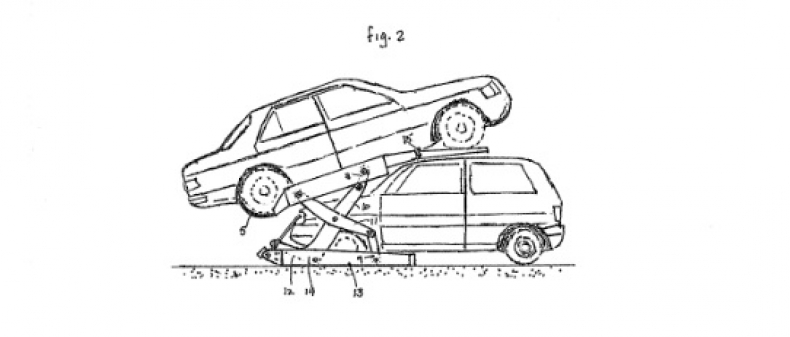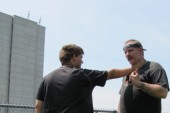
According to the Canadian Intellectual Property Office (CIPO) database, there were more than two million patents created by Torontonians in 2012. Seems like a lot, but most of the registered patents are re-jigged add-ons for an existing invention. Let’s say you’ve invented a high-tech electronic door and now you’ve decided to add a remote control option to it, or you have worked out how to make the door move from a remote location — the CIPO database is full of patents for that kind of stuff. Some of the patents we sifted through were first lodged more than 20 years ago, but are continually updated with the latest gadgets and improvements. We decided to take a look through the database and search for the best, most useful and bizarre urban patents of 2012 invented by Torontonians (and some from Montreal).
The inventors: Paul Harris and Jerome Roy
The patent: At a North American trade show in L.A. some five years ago, Paul Harris says, after trying bikes that seemed dangerous or not practical enough for the changing urban environment, he along with co-patent designer Jerome Roy, came up with the urban bike idea. This sturdy urban steed is strong enough to hold a passenger and take the load of a box of groceries all on the back rack without too much ‘wobble-factor’. And you don’t need quads of steel to ride it. It can also manoeuvre in and out of traffic, like a quick and nimble horse. The seat is adjustable and can fit just about anyone from 5ft to more than 6ft tall. The bike’s tires are much larger than your average mountain bike, spanning at 2.35 inches (mountain bikes stop at two inches) which was the point to begin with according to Harris. “It’s a throw back to the 40s where bikes had balloon tyres and when roads were terrible and full of pot holes,” he said. “We made the tyres with greater volume to accommodate bumps, to make it more comfortable.” For those wanting a fixed-gear bike death wish, look elsewhere. The bikes are now available on the Toronto market at places such as Issie Cycling and Station Ski and Ride.
2. The two-in-one car-parking tool.
The inventors: LoongYip Juy and Ana Cecilia Juy
The patent: Don’t you despise the lack of parking spots in the city? What if I told you, you could one day perhaps park on top of another car? The two-in-one car-parking tool is a “lifting” device that will allow two cars to park in one space. The entire structure is bolted to the ground initially, but is also portable. It’s not something we could own individually, rather a city-owned electrical device. After the first car positions itself on the steel platform and settles into the bent grooves shaped like tyres, it is then lifted up upon activation of the electric motor. When it reaches its highest point, the second car can be driven in underneath the platform. The device comes with a bolt stopper, to prevent cars from rolling, being moved or tipped. It can be used indoors, such as underground and also at home in your parking garage — depending on how tall your ceiling is. This urban parking tool also comes with a built-in sensor, so when two cars vacate the parking area, it lowers itself to the ground. The only question is: how much will this cost?
3. Anti-theft (and weather) newspaper holder.
The inventors: Wendy Daniel-Lenson and Peter Lenson.
The patent: Nothing’s worse when you walk to your front door to collect your newspaper in the morning and it’s not there. You start blaming the neighbour’s kids for it or the single middle-aged guy down the road who lives with eight cats for the theft of your news. Here’s a neat way to nix it: the anti-theft newspaper holder. The stretchable cloth bag has four parts to it: a rectangular trunk the size of a typical newspaper, a weather protective flap that sits on top of the trunk, an anti-theft collar and a 15-inch carry handle which can be secured to a door knob. When the paper gets delivered and placed inside the holder, the newspaper is secured by the collar that sits at the top. If someone tries to steal the newspaper, it catches the collar, similar to a barb on a fish hook. The thief then struggles for a moment or two before realizing he can’t get the newspaper. He takes off down the road and steals your neighbour’s paper left out on the front lawn. If your neighbourhood thief really wants your newspaper, there is nothing stopping them picking up a pair of scissors or a sharp knife and taking a blade to the holder, but, this humble anti-theft bag would still act as a good deterrent. Thieves will take one look at the bag and confusion will set in.
4. The washroom bus.
The inventor: Juan Bautista Truqui
The patent: What should we do with the city’s old buses? Turn them into toilets, of course. Before we start thinking about sending the old TTC buses to the scrap heap, let’s think about this: the washroom bus. Imagine there were buses parked around the city that had anywhere from 1-100 toilet cubicles strapped inside it and came equipped with T.V., internet, foldable chairs and air-conditioning? It’s like stepping into the future. The washroom bus would be far more superior than the port-a-loo we know because it would have fresh, flowing water and a sewage system to release the waste into. The water source would either hail from an independent roof-top tank, a separate canopy or from a hose connected to the public recycled water system. As for disposing of the waste, the idea would be to connect to the city’s sewer lines through pumps and hoses or they would have their own waste compartment under the floor.
The inventor: Michele Palladino
The patent: This invention is straight out of the Back to The Future II handbook: ways to avoid your nemesis (mainly the Biffs of the world). This specific idea is meant to improve the technology of snowboards, by adding air cushions and thus increasing the speed and maneuverability. But, I’d like to see this invention make its way into everyday urban life, such as getting groceries, meeting up with friends at the park and hanging onto the back of cars driving along the Gardiner Expressway (that would be something). Who doesn’t want to be suspended in air and to travel at great speeds? Wheels are for chumps; air is where it’s at.
The inventor: Ahmad Amiri
The patent: Also known as a “narrow vehicle” or a “narrow transit system”, it’s an alternative transit system. But just how narrow is it? Well, it’s smaller than a city bike lane, so, probably not one for the masses. It’s measurements consist of being 10 rows long, 70cm wide and 150cm high. It fits one seat per person in a real squeeze and each seat has a corresponding door for entry and exit. It’s kind of like a smart car, only it’s a narrow bus. It’s battery operated, uses wireless auto-steering and can fit a scooter inside the cabin. There’s room for bikes (not too many) on top. The smart-bus would ideally operate in a dedicated lane close to the curb in a network of trenchways (yes, trenchways) that look like deep pipeplines to avoid traffic and crossroads. This 76-page document explains how it can be used and how the elements would work and the ways in which people would get on or off (i.e. if there are allocated stops).
The inventor: Urban Construction Equipment LTD.
The patent: It’s a steel elevator on wheels. It can go as high as 15 metres and has a frame weight of 5000kgs. The patent says it’s more tailored to construction sites and to be used on building structures. And why not. Taking the elevator up to lofty heights beats taking the rattley scaffolding; it’s more efficient and safe. It can also be used in a harbour where, for example, if there is a wet dock where ships aren’t raised in from the water, the portable elevator can pull cargo off the ship without being attached to it. The ship can come and go as it pleases. I can also see this being used by millionaires who need to retrieve a soccer ball from their rooftop three-story mansion, kicked up there by their rich son.
The inventor: Bill Marangos
The patent: Inside this battered-powered cigarette, L.E.D indicators control how the nicotine (or flavour vapors) is inhaled and even stores data on how the cigarette is used. The neat thing about the e-cigarette there is no smoke combustion. When inhaled, it gives you a heat sensation that emulates a real lit cigarette. When you puff on the device, it then becomes “activated” through a series of micro-controllers and then emits the vapors into your mouth and lungs. It doesn’t smell like a cigarette and looks more like a prosthetic arm. Aesthetics aside, could this be the cigarette of the future that Torontonians will flock to as smoking is criminalized?
The inventor: Tibor Zoltan Harmathy
The patent: What’s the one thing in the world that you wish to avoid walking down city streets? Well, the answer might not stairs, but just in case it was your prayers could be answered. This patent is aimed at our ageing population who live in apartments that may not have access to an elevator, but instead, have to face the arduous task of walking up and down stairs. Yes, we’ve all seen the chairlifts, that are often in aged-care facilities, but costs for these run sky-high according to this patent. It’s operates much like the portable elevator, in that a platform exists for the user. They hop on it and secure themselves, then move and down in a vertical fashion. It’s built for safety, for the elderly who use a wheelchair; it’s not built to shave off time.
10. Construction — the board game!
The inventor: Viorel Ioan Neacsu
The patent: You can’t get more urban than a patent for a board game that requires you to build vertical towers and cities. This should have construction workers frothing at the mouth. You use balls, rings and wooden legs (that come in varied sizes) to build a tower from the base up until one person reaches the required top ring. It’s a race, so don’t dawdle. The difficulty grows as the tower grows. Turn off the air-conditioning unit for this one, any slight wind or air disturbance could affect the outcome of this game. In an exciting twist, a player can opt to re-build his or her structure and take down the building level by level in order to find the right path to success. Sounds a lot like Jenga with ping pong balls. How do you get the balls to stay in place? Impossible, right? Well, it most likely is.
____
Justin Robertson is a freelance journalist from Toronto. His work has appeared in The Walrus, National Post and Toronto Standard. Follow Justin on Twitter @justinjourno
For more, follow us on Twitter @TorontoStandard and subscribe to our newsletter.














